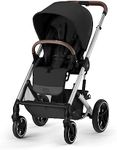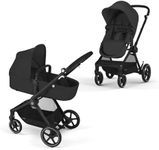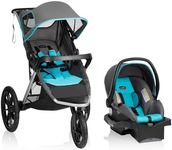Buying Guide for the Best Travel Strollers For Toddlers
Choosing a travel stroller for toddlers can make your trips much smoother and more enjoyable. The right stroller should be lightweight, easy to fold, and comfortable for your child, while also being convenient for you to carry and maneuver. When shopping, think about where and how you’ll use the stroller most—airports, city streets, or rougher terrain—and consider your child’s comfort and safety as top priorities. Understanding the key features will help you find a stroller that fits your travel style and your toddler’s needs.WeightWeight refers to how heavy the stroller is when empty. This is important because a lighter stroller is easier to carry, lift into cars or overhead bins, and maneuver through crowded places. Travel strollers typically range from ultra-lightweight (under 13 pounds), which are great for frequent flyers or those who need to carry the stroller often, to mid-weight (13-20 pounds), which may offer more features but are a bit heavier. If you’ll be carrying the stroller a lot or using public transport, go for the lightest option you can find that still feels sturdy. If you need more comfort features and don’t mind a bit of extra weight, a mid-weight stroller might be better.
FoldabilityFoldability describes how easily and compactly the stroller can be folded. This matters because a stroller that folds quickly and into a small size is much easier to store in car trunks, airplane overhead bins, or hotel rooms. Some strollers fold with one hand, which is helpful if you’re holding your child. Others require two hands or several steps. If you travel alone with your toddler or need to fold the stroller often, look for a one-hand, quick-fold design. If you have help or don’t need to fold it as often, a more complex fold might be acceptable.
Recline and ComfortRecline and comfort features refer to how much the seat can lean back and what kind of padding or support it offers. This is important for your toddler’s comfort, especially during naps on the go. Some strollers offer a deep or full recline, which is great for younger toddlers who still nap frequently, while others have a more upright seat suitable for older, more active toddlers. If your child naps in the stroller, look for a model with a deep recline and good head support. If your toddler prefers to sit up and look around, a stroller with a more upright seat and less padding may be fine.
Canopy SizeThe canopy is the cover that shields your child from the sun, wind, or light rain. A larger canopy offers better protection, which is especially important if you’ll be outdoors a lot. Canopies range from small (just covering the head) to extra-large (covering most of the seat). If you travel to sunny or rainy places, or if your toddler is sensitive to light, choose a stroller with a large, adjustable canopy. If you’ll mostly be indoors, a smaller canopy may be sufficient.
Storage BasketThe storage basket is the space under the seat where you can keep bags, snacks, or other essentials. This is important for convenience, especially when traveling, as you may need to carry extra items. Storage baskets vary in size from very small (just enough for a diaper bag) to large (enough for shopping bags or extra gear). If you like to keep your hands free or carry a lot, look for a stroller with a roomy, easy-to-access basket. If you travel light, a smaller basket may be enough.
ManeuverabilityManeuverability refers to how easily the stroller moves and turns, especially in tight spaces or on uneven surfaces. This depends on the wheel size, suspension, and handle design. Strollers with swivel front wheels and good suspension are easier to push and turn, which is helpful in airports, city streets, or crowded places. If you’ll be using the stroller mostly on smooth surfaces, basic wheels are fine. For rougher terrain or lots of walking, look for larger wheels and better suspension.
Safety FeaturesSafety features include the harness (straps that keep your child secure), brakes, and stability of the stroller. A five-point harness is the safest, as it secures your child at the shoulders, waist, and between the legs. Reliable brakes are important for stopping the stroller on slopes or busy streets. If you’ll be using the stroller in busy or uneven areas, prioritize strong safety features. For occasional, supervised use, basic safety features may be enough.
Age and Weight LimitThe age and weight limit tells you the maximum size and age of child the stroller can safely carry. This is important to ensure your toddler fits comfortably and the stroller remains safe to use. Limits vary, with some strollers suitable up to 40-50 pounds, while others are designed for smaller children. If your toddler is tall or heavier for their age, check the upper limits to make sure the stroller will last as long as you need it.



















